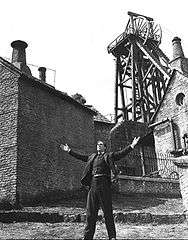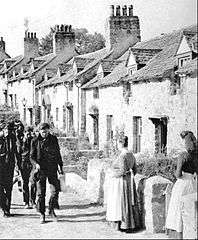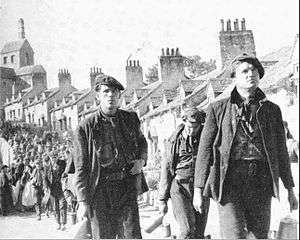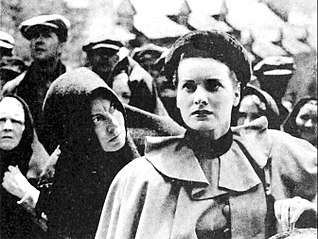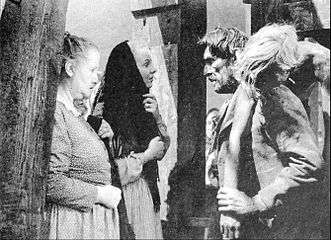How Green Was My Valley (film)
How Green Was My Valley is a 1941 drama directed by John Ford. The film, based on the best-selling 1939 novel of the same name by Richard Llewellyn, was produced by Darryl F. Zanuck and scripted by Philip Dunne. The film stars Walter Pidgeon, Maureen O'Hara, Anna Lee, Donald Crisp, and Roddy McDowall. It was nominated for ten Academy Awards,[3] famously beating Citizen Kane, Sergeant York and The Maltese Falcon for Best Picture. It also won Best Director, Best Cinematography, and Best Supporting Actor.
| How Green Was My Valley | |
|---|---|
.jpg) Theatrical release poster | |
| Directed by | John Ford |
| Produced by | Darryl F. Zanuck |
| Screenplay by | Philip Dunne |
| Based on | How Green Was My Valley 1939 novel by Richard Llewellyn |
| Starring | Walter Pidgeon Maureen O'Hara Donald Crisp Anna Lee Roddy McDowall |
| Narrated by | Irving Pichel |
| Music by | Alfred Newman |
| Cinematography | Arthur C. Miller |
| Edited by | James B. Clark |
| Distributed by | Twentieth Century-Fox Film Corporation |
Release date |
|
Running time | 118 minutes |
| Country | United States |
| Language | English Welsh |
| Budget | $800,000[1] |
| Box office | $2.8 million (US rentals)[2] |
The film tells the story of the Morgans, a hard-working Welsh mining family, from the point of view of the youngest child Huw, who lives with his affectionate and kind parents, and his five brothers, in the South Wales Valleys during the late Victorian era. The story chronicles life in the South Wales coalfields, the loss of that way of life and its effects on the family. The fictional village in the film is based on Gilfach Goch;[4] Llewellyn spent many summers there visiting his grandfather, and it served as the inspiration for the novel.[4]
In 1990, the film was selected for preservation in the United States National Film Registry of the Library of Congress as being "culturally, historically, or aesthetically significant". The Academy Film Archive preserved How Green Was My Valley in 1998.[5]
Plot

The film begins with a monologue by an older Huw Morgan (voiced by Irving Pichel):[lower-alpha 1] "I am packing my belongings in the shawl my mother used to wear when she went to the market. And I'm going from my valley. And this time, I shall never return." The valley and its villages are now blackened by the dust of the coal mines that surround the area.
A young Huw (Roddy McDowall), the youngest child of Gwilym Morgan (Donald Crisp), walks home with his father to meet his mother, Beth (Sara Allgood). His older brothers, Ianto (John Loder), Ivor (Patric Knowles), Davy (Richard Fraser), Gwilym Jr. (Evan S. Evans), and Owen (James Monks) all work in the coal mines with their father, while sister Angharad (Maureen O'Hara) keeps house with their mother. Huw's childhood is idyllic, the town, not yet overrun with mining spoil, is beautiful, and the household is warm and loving, the miners sing as they walk home (in this case Bread of Heaven in Welsh). The wages are collected, the men wash then eat together. Afterwards the spending money is given out. Huw is smitten on meeting Bronwyn (Anna Lee), a girl engaged to be married to his eldest brother, Ivor (Patric Knowles). At the boisterous wedding party Angharad meets the new preacher, Mr. Gruffydd (Walter Pidgeon), and there is an obvious mutual attraction.
Trouble begins when the mine owner decreases wages, and the miners strike in protest. Gwilym's attempt to mediate by not endorsing a strike estranges him from the other miners as well as his older sons, who quit the house. Beth interrupts a late night meeting of the strikers, threatening to kill anyone who harms her husband. While returning home, crossing the fields in a snowstorm in the dark, Beth falls into the river. Huw dives in to save her with the help of the townspeople, and temporarily loses the use of his legs. He recovers with the help of Mr. Gruffydd, which further endears the latter to Angharad.
The strike is eventually settled, and Gwilym and his sons reconcile, yet many miners have lost their jobs. Angharad is courted by the mine owner's son, Iestyn Evans (Marten Lamont), though she loves Mr. Gruffydd. Mr. Gruffydd loves her too, to the malicious delight of the gossipy townswomen, but cannot bear to subject her to an impoverished churchman's life. Angharad submits to a loveless marriage to Evans, and they relocate out of the country.
Huw begins school at a nearby village. Abused by other boys, he is taught to fight by boxer Dai Bando (Rhys Williams) and his crony, Cyfartha (Barry Fitzgerald). After a beating by the cruel teacher Mr. Jonas (Morton Lowry), Dai Bando avenges Huw with an impromptu boxing display on Mr. Jonas to the delight of his pupils.
On the day that Bronwyn gives birth to their child, Ivor is killed in a mine accident. Later, two of Morgan's sons are dismissed in favor of less experienced, cheaper laborers. With no job prospects, they leave to seek their fortunes abroad. Huw is awarded a scholarship to university, but to his father's dismay he refuses it to work in the mines. He relocates with Bronwyn, to help provide for her and her child.
When Angharad returns without her husband, vicious gossip of an impending divorce spreads through the town. Mr. Gruffydd is denounced by the church deacons, and after condemning the town's small-mindedness, he decides to leave.
Just then, the alarm whistle sounds, signalling another mine disaster. Several men are injured, and Gwilym and others are trapped in a cave-in. Young Huw, Mr. Gruffydd, and Dai Bando descend with others for a rescue attempt. Gwilym and his son are briefly re-united before he succumbs to his injuries. Huw rides the lift to the surface cradling his father's body, his coal-blackened face devoid of youthful innocence.
Narration by an older Huw recalls, "Men like my father cannot die. They are with me still, real in memory as they were in flesh, loving and beloved forever. How green was my valley then." The movie ends with a montage of family vignettes showing Huw with his father and mother, his brothers and sister.
Cast
|
|
Production
The script was written by Philip Dunne. He later recalls reading the original novel "in horror, turgid stuff, long speeches about Welsh coal miners on strike."[7]
William Wyler, the original director, saw the screen test of McDowall and chose him for the part. Wyler was replaced by John Ford. Fox wanted to shoot the movie in Wales in Technicolor, but events in Europe during World War II made this impossible. Instead, Ford had the studio build an 80-acre authentic replica of a Welsh mining town at Brent's Crags[6] (subsequently Crags Country Club) in the Santa Monica Mountains near Malibu, California.[8]
The cast had only one Welsh actor, Rhys Williams, in a minor role.
Reception
.jpg)
How Green Was My Valley maintains a 90% approval rating at Rotten Tomatoes based on 42 reviews, with a weighted average of 8.04/10. The site's consensus reads: "Though it perhaps strays into overly maudlin territory, this working-class drama is saved by a solid cast and director John Ford's unmistakeable style."[9] Tim Dirks of Filmsite.org lauded the film as "one of John Ford's masterpieces of sentimental human drama."[10]
While the opinion among the Academy Awards committee that it was 1941's Best Picture has been disputed by some later critics,[11][12] How Green Was My Valley continues to be well received in its own right and, in 1990, was added to the American National Film Registry. Academy Award-winning actor and director Clint Eastwood named it as one of his favorite movies.[13]
Awards
Academy Awards
- Winners[14]
- Best Picture - Darryl F. Zanuck
- Best Director - John Ford
- Best Supporting Actor - Donald Crisp
- Best Black-and-White Cinematography - Arthur Miller
- Best Black-and-White Art Direction-Interior Decoration - Richard Day, Nathan H. Juran and Thomas Little
- Nominations
Other awards
- New York Film Critics Circle Awards: NYFCC Award; Best Director, John Ford; 1941.
- Silver Condor Award for Best Foreign Film at the 1943 Argentine Film Critics Association Awards in Argentina, John Ford, USA; 1943.[15]
- 1990—National Film Registry.
- American Film Institute Lists
- AFI's 100 Years...100 Movies - Nominated[16]
- AFI's 100 Years...100 Movie Quotes:
- "Men like my father cannot die. They are with me still -- real in memory as they were in flesh, loving and beloved forever. How green was my valley then." - Nominated[17]
- AFI's 100 Years of Film Scores - Nominated[18]
- AFI's 100 Years...100 Movies (10th Anniversary Edition) - Nominated[19]
Adaptations
How Green Was My Valley was adapted as a radio play on the March 22, 1942 broadcast of the Ford Theatre, with Sara Allgood, Donald Crisp, Roddy McDowall, Maureen O'Hara and Walter Pidgeon.
It was also adapted on three broadcasts of Lux Radio Theater: on September 21, 1942, with Allgood, Crisp, O'Hara, McDowall and Pidgeon; on March 31, 1947, with Crisp and David Niven; and on September 28, 1954, with Crisp and Donna Reed.
A Broadway musical adaptation, entitled A Time for Singing, produced by Alexander H. Cohen, opened at the Broadway Theatre on May 21, 1966. The music was by John Morris; book and lyrics by Morris and Gerald Freedman, who also served as the director. Cast included Laurence Naismith as Gwillym, Tessie O'Shea as Beth Morgan, Shani Wallis as Angharad and Frank Griso as Huw.
See also
References
- Footnotes
- Some sources credit the narration to Rhys Williams[6]
- Citations
- Solomon, Aubrey (1989). Twentieth Century Fox: A Corporate and Financial History. Lanham, Maryland: Scarecrow Press, p. 241, ISBN 978-0-8108-4244-1.
- "101 Pix Gross in Millions", Variety, 6 Jan 1943, p. 58
- "How Green Was My Valley". The New York Times. Archived from the original on 2009-03-02. Retrieved 2008-12-13.
- (February 7, 2009)"How Green Was My Valley", BBC Radio Wales. Retrieved August 20, 2019.
- "Preserved Projects". Academy Film Archive. Retrieved August 20, 2019.
- Maltin, Leonard. "How Green Was My Valley (1941) - Notes - TCM.com". Turner Classic Movies. TCM Interactive Group. Retrieved August 20, 2019.
- Philip Dunne looks back at movies' golden age: [SA2 Edition]Jim Bawden Toronto Star 27 Jan 1990: G8.
- Rasmussen, Cecilia (January 21, 2007). "Hollywood and the History of Malibu Creek State Park". Los Angeles Times. Ventura County Trails. Retrieved August 20, 2019.
- "How Green Was My Valley (1941)". Rotten Tomatoes. Fandango Media. Retrieved August 20, 2019.
- Dirks, Tim. "How Green Was My Valley (1941)". AMC. Retrieved August 20, 2019.
- Susman, Gary (February 19, 2013). "Oscar Robbery: 10 Controversial Best-Picture Races – 1942: 'Citizen Kane' vs. 'How Green Was My Valley'". TIME.
- Hathaway, Hashim (January 25, 2017). "25 times the Oscars got it wrong". Yardbarker. Retrieved April 20, 2019.
- "Clint Eastwood's Favorite 'Golden Age' Films". Parade. April 29, 2012.
- "The 14th Academy Awards (1942) Nominees and Winners". Retrieved August 20, 2019.
- "Historia de la Asociación de Cronistas Cinematográficos de la República Argentina". Puestaenescena.com.ar. Retrieved August 20, 2019.
- "AFI's 100 Years...100 Movies Nominees" (PDF). afi.com. Retrieved August 20, 2019.
- "AFI's 100 Years...100 Movie Quotes Nominees" (PDF). afi.com. Retrieved August 20, 2019.
- "AFI's 100 Years of Film Scores Nominees" (PDF). afi.com. Retrieved August 20, 2019.
- "AFI's 100 Years...100 Movies (10th Anniversary Edition) Ballot" (PDF). afi.com. Retrieved August 20, 2019.
External links
| Wikiquote has quotations related to: How Green Was My Valley (film) |
| Wikimedia Commons has media related to How Green Was My Valley. |
- How Green Was My Valley on IMDb
- How Green Was My Valley at the TCM Movie Database
- How Green Was My Valley at AllMovie
- How Green Was My Valley at the American Film Institute Catalog
- How Green Was My Valley at Rotten Tomatoes
- How Green Was My Valley at Reel Classics
- How Green Was My Valley at Film Site web site; contains plot detail.

